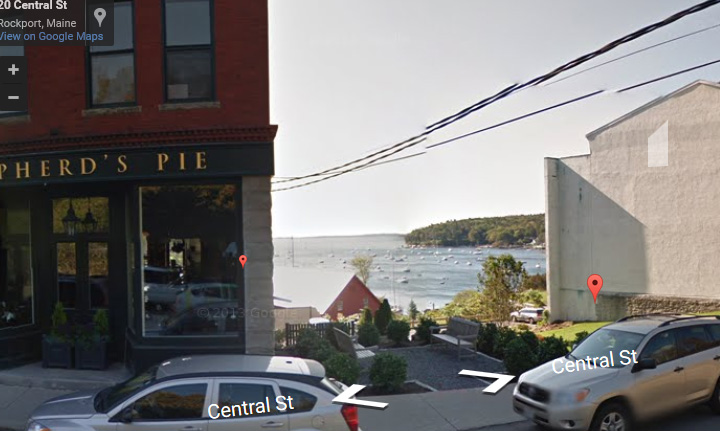During their last several meetings, Rockport Ordinance Review Committee members have been talking with Rockport Village business and property owners about zoning and allowing hotels to be built on Central Street, and the east side of Rockport Harbor. The ORC and others will continue the conversation Thursday, Dec. 14, at 8 a.m. in the Richardson Room at the Rockport Town Office.
The conversation began first when Camden resident and hotel owner Stuart Smith, who owns several properties on Central Street in Rockport Village, approached the Rockport planning office about possibly constructing a new hotel on one of the parcels on Central Street that he and his wife, Marianne, purchased in July 2016.
Smith purchased the properties under the name of 14-16 Central Street LLC, and 20 Central Street LLC, and as the names imply, the empty properties are 14 and 16 Central Street, as well as 20 Central Street. The Smiths also purchased 18 Central Street, otherwise known as the the Shepherd Block, the large brick building that had been renovated by Leucadia Corp. in the last decade.
The empty parcels bracket either side of the Shepherd Block, and overlook Rockport Harbor. 14-16 Central is bounded on one side by the town-owned Mary Lea Park, while 20 Central St. abuts the white-walled 22 Central St., owned by Barbara Jackson. Except, the wall itself is under the ownership 20 Central Street, and reflects property ownership of a town when it was a more an industrial hub of lime processing and shipbuilding, and less a Village concentrating on art, music and culture.
The Rockport Select Board decided Oct. 11 to direct the Ordinance Review Committee to address the issue of ordinance language governing hotel use in the 913 section of Rockport Village.
The directive to the committee to address hotel use in the 913 Downtown District zone ranked No. 1 on list of work the Select Board wants the ORC to accomplish.
According to Rockport Planner James Francomano, the ORC has been talking with landowner Stuart Smith about his hopes to construct a hotel on Central Street for the last three or four meetings.
“Stuart and Tyler Smith plan to construct a hotel at one of the two addresses on Central Street and are requesting a change in zoning to all that,” said Francomano. “They intend to keep the historic look.”
In June 2016, a change to the ordinance governing District 913 was posed to voters, and approved.
That article, which appeared on the Rockport town warrant, asked voters: “Shall an ordinance entitled ‘Ordinance amending the Town of Rockport Land Use Ordinance, Section 1400 — Shoreland Zoning, Section 917 — Land Use Table, 918 — Dimensional Table and Section 913 — Downtown, which would clarify the permitted uses and standard for development in a portion of the Section 913 Downtown zoning district,’ be enacted?”
The measure passed, Yes: 594; No: 108.
Francomano said those changes were introduced as part of the “town’s general downtown revitalization effort; i.e., returning to historic development patterns (including zero setbacks, increased height) to make redevelopment viable.”
The purpose of the zoning in the 913 Downtown District is to: “preserve and enhance the mixture of small businesses, civic, educational, residential, and water dependent development in the core of the Downtown District and to provide additional uses and alternative standards for increased development potential on specific lots with street frontage on Central Street
and Main Street consistent with historical patterns of development,” according to the Rockport Land Use Ordinance.
District 913 is one of the smallest zones in town and comprises a small area that extends from the commercial fishermen’s wharf, up to Union Hall, and runs on the east side of Central Street all the way the former CMCA gallery on Russell Ave. The zone includes the boatyard Rockport Marine.
It is abutted on all sides, except the ocean, by District 901, Harbor Village.
In District 913, the ordinance stipulates that:
At street level within the first twenty (20) feet of buildings facing Central Street within these bounds only Commercial Uses are permitted.
(b) In addition to Uses otherwise permitted in the Downtown District, the Residential Multi family Use, as defined, shall be permitted within these bounds.
(c) In addition to Uses otherwise permitted in the Downtown District, t he following non-Residential Uses, as defined, shall be permitted within these bounds: Art Galleries; Barber Shop/Salon; Medical Clinics; and Places of Assembly.
(d) In addition to Uses otherwise permitted in the Downtown District, the following Uses, as defined, shall be permitted by Special Exception within these bounds: all Industrial/ Manufacturing/Transportation/Wholesale Uses found in the table at Section 917 except Agricultural product processing and Wholesale facility.
(e) The following alternative Standards shall apply to parcels with street frontage on Central Street within these bounds.
Furthermore:
There shall be no minimum setbacks.
(2) There shall be no maximum lot coverage.
(3) T here shall be no minimum lot area per dwelling unit.
(4) The maximum building height shall be fifty (50) feet measured from the highest point on the Central Street sidewalk adjacent to the foundation.
(5) The maximum height at the eave shall be forty (40) feet measured from the highest point on the Central Street sidewalk adjacent to the foundation.
(6) Within buildings facing Central Street, the minimum depth of Commercial Uses at street level shall be the first twenty (20) feet.
(7) The minimum street frontage shall be twenty (20) feet
In July 2016, Smith said ideas were under discussion for the vacant lots. He and Town Manager Rick Bates had been exploring opportunities for the village, whose broadband infrastructure was upgraded two years ago, and has since attracted the attention of businesses and nonprofits that rely on high-speed internet.
Leucadia Development Corp., a subsidiary of the New York City and Utah-based holding company Leucadia National, arrived in the Midcoast in 2005, bought 76 acres on Islesboro and planned a subdivision there. The company then set sights on Rockport, buying 115 acres on Brewster Point, and proposed a clustered subdivision development there.
Leucadia bought 19 Main St., then Maine Media Workshops and Union Hall, as well as the Camden Street campus, from its former owner David Lyman. Then, it acquired the Masonic Hall, opposite Union Hall, and then the Shepherd Block, and adjacent small wooden homes. The two homes were demolished, and Leucadia began pouring in millions to its Rockport real estate holdings, sprucing up Rockport Village in the process, infusing it with energy.
Then, with the 2009 recession, Leucadia pulled back and began divesting of its total $38 million Rockport holdings. This latest real estate agreement between the company and Smith is one more step in that process.
Reach Editorial Director Lynda Clancy at lyndaclancy@penbaypilot.com; 207-706-6657
.
































